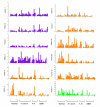Differential expression of 12 histone deacetylase (HDAC) genes in astrocytomas and normal brain tissue: class II and IV are hypoexpressed in glioblastomas
- PMID: 18713462
- PMCID: PMC2536671
- DOI: 10.1186/1471-2407-8-243
Differential expression of 12 histone deacetylase (HDAC) genes in astrocytomas and normal brain tissue: class II and IV are hypoexpressed in glioblastomas
Abstract
Background: Glioblastoma is the most lethal primary malignant brain tumor. Although considerable progress has been made in the treatment of this aggressive tumor, the clinical outcome for patients remains poor. Histone deacetylases (HDACs) are recognized as promising targets for cancer treatment. In the past several years, HDAC inhibitors (HDACis) have been used as radiosensitizers in glioblastoma treatment. However, no study has demonstrated the status of global HDAC expression in gliomas and its possible correlation to the use of HDACis. The purpose of this study was to evaluate and compare mRNA and protein levels of class I, II and IV of HDACs in low grade and high grade astrocytomas and normal brain tissue and to correlate the findings with the malignancy in astrocytomas.
Methods: Forty-three microdissected patient tumor samples were evaluated. The histopathologic diagnoses were 20 low-grade gliomas (13 grade I and 7 grade II) and 23 high-grade gliomas (5 grade III and 18 glioblastomas). Eleven normal cerebral tissue samples were also analyzed (54 total samples analyzed). mRNA expression of class I, II, and IV HDACs was studied by quantitative real-time polymerase chain reaction and normalized to the housekeeping gene beta-glucuronidase. Protein levels were evaluated by western blotting.
Results: We found that mRNA levels of class II and IV HDACs were downregulated in glioblastomas compared to low-grade astrocytomas and normal brain tissue (7 in 8 genes, p < 0.05). The protein levels of class II HDAC9 were also lower in high-grade astrocytomas than in low-grade astrocytomas and normal brain tissue. Additionally, we found that histone H3 (but not histone H4) was more acetylated in glioblastomas than normal brain tissue.
Conclusion: Our study establishes a negative correlation between HDAC gene expression and the glioma grade suggesting that class II and IV HDACs might play an important role in glioma malignancy. Evaluation of histone acetylation levels showed that histone H3 is more acetylated in glioblastomas than normal brain tissue confirming the downregulation of HDAC mRNA in glioblastomas.
Figures



Similar articles
-
Expression and prognostic impact of matrix metalloproteinase-2 (MMP-2) in astrocytomas.PLoS One. 2017 Feb 24;12(2):e0172234. doi: 10.1371/journal.pone.0172234. eCollection 2017. PLoS One. 2017. PMID: 28234925 Free PMC article.
-
N-acetyl l-aspartate and Triacetin modulate tumor suppressor MicroRNA and class I and II HDAC gene expression induce apoptosis in Glioblastoma cancer cells in vitro.Life Sci. 2021 Dec 1;286:120024. doi: 10.1016/j.lfs.2021.120024. Epub 2021 Oct 7. Life Sci. 2021. PMID: 34626605
-
High CHI3L1 expression is associated with glioma patient survival.Diagn Pathol. 2016 Apr 27;11:42. doi: 10.1186/s13000-016-0492-4. Diagn Pathol. 2016. PMID: 27121858 Free PMC article.
-
[Epigenetic mechanisms and alcohol use disorders: a potential therapeutic target].Biol Aujourdhui. 2017;211(1):83-91. doi: 10.1051/jbio/2017014. Epub 2017 Jul 6. Biol Aujourdhui. 2017. PMID: 28682229 Review. French.
-
Altered expression of histone deacetylases in cancer.Crit Rev Oncog. 2015;20(1-2):19-34. doi: 10.1615/critrevoncog.2014012554. Crit Rev Oncog. 2015. PMID: 25746102 Review.
Cited by
-
An HDAC9-associated immune-related signature predicts bladder cancer prognosis.PLoS One. 2022 Mar 3;17(3):e0264527. doi: 10.1371/journal.pone.0264527. eCollection 2022. PLoS One. 2022. PMID: 35239708 Free PMC article.
-
Focal nature of neurological disorders necessitates isotype-selective histone deacetylase (HDAC) inhibitors.Mol Neurobiol. 2009 Aug;40(1):33-45. doi: 10.1007/s12035-009-8067-y. Epub 2009 Apr 28. Mol Neurobiol. 2009. PMID: 19396637 Review.
-
Unraveling the Epigenetic Role and Clinical Impact of Histone Deacetylases in Neoplasia.Diagnostics (Basel). 2021 Jul 26;11(8):1346. doi: 10.3390/diagnostics11081346. Diagnostics (Basel). 2021. PMID: 34441281 Free PMC article. Review.
-
Histone deacetylases and cancer.Mol Oncol. 2012 Dec;6(6):579-89. doi: 10.1016/j.molonc.2012.07.003. Epub 2012 Aug 27. Mol Oncol. 2012. PMID: 22963873 Free PMC article. Review.
-
HDAC9 is implicated in schizophrenia and expressed specifically in post-mitotic neurons but not in adult neural stem cells.Am J Stem Cells. 2011 Aug 18;1(1):31-41. Print 2012. Am J Stem Cells. 2011. PMID: 23671795 Free PMC article.
References
-
- Gallinari P, Di Marco S, Jones P, Pallaoro M, Steinkuhler C. HDACs, histone deacetylation and gene transcription: from molecular biology to cancer therapeutics. Cell research. 2007;17:195–211. - PubMed
MeSH terms
Substances
LinkOut - more resources
Full Text Sources
Other Literature Sources
Medical
Miscellaneous

